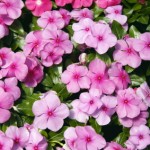Impatiens, Jewelweed
The impatiens (Impatiens) genus of flowering plants is widely distributed throughout the northern hemisphere and the tropics. It is made up of 850-1000 species. Some botanists believe that the large genus needs to be split into two based on the genetic make-up of individual plants. Additional common names for the plants include jewelweeds, balsams, and touch-me-nots. Jewelweed is typically applied to North American species, balsam to tropical ones, and touch-me-not to European varieties. One of the most common species is known as Busy Lizzie (Impatiens walleriana). The Busy Lizzie is native to Kenya and Mozambique in Africa and comes in a variety of colors including white, pink, and red.
More often than not most species are annuals and they bloom from early summer until the first frost, then are discarded. Other species found in milder climates are perennials and they can flower all year under the right conditions. The largest impatiens reach about two meters in height, but most stay around one meter. The leaves are shiny and have a greasy texture from the water-repellent cuticula. The underside of the leaves have a silvery sheen when wet, and could be the origin of the name jewelweed. Another theory about the origin of that particular name is from the light blue surface of the seeds under the dark brown seed coat, which also resemble jewels. The name touch-me-not definitely derived from the seed capsules. When they are mature they will pop when touched, shooting seeds several meters away.
The flowers are usually horn-shaped and about an inch long, but the Busy Lizzie resembles a violet in shape, and some varieties have double flowers. The differing flower shapes make the impatiens a model organism in studies of plant evolutionary biology. They come in white, shades of pink, red, orange, and purple. The flowers are easy to grow in well-drained soil, in containers or in or our of full sun. They are easily propagated from cuttings, which you can place directly in either your yard or a pot. They will take root in a few weeks to a month. To propagate from seeds, they simply need to be planted in moist ground with light shade and you can gradually move them to areas with more light as they sprout. The most challenging part of growing them may very well be picking what color you would like.
In the nineteenth and twentieth century the Orange Jewelweed (Impatiens capensis) was brought to England and Scandinavia. It is seldom grown in gardens, but has since became naturalized and can be found growing along rivers. The Orange Jewelweed is similar to the Touch-me-not Balsam (Impatiens noli-tangere), which was originally the only impatiens species native to northern and central Europe. The Small Balsam (Impatiens parviflora), originally native only to southern Asia, has also become naturalized in Europe. The only species that has thus far posed a problem is the Hymalayan Balsam (Impatiens grandulifera) because it grows taller than the other varieties and blocks sunlight to the native plants, tending to dominate the areas where it grows. It has subsequently made riverbanks more prone to erosion. Even the Busy Lizzie is considered a weed in tropical areas where it can flourish out of control quickly, like Hawaii.
Impatiens leaves are bitter tasting and toxic to most animals, but are a food source for some butterfly and moth species. Impatiens are good for attracting bees if you would like to encourage them. The North American jewelweed species have long been a folk remedy for treating insect bites and poison ivy, but according to many studies the plants have no actual antipruritic effects - they do though contain anti-inflammatory compounds and fungicides. In ancient China, crushed impatiens petals were used for nail polish, coloring them pink or red. Traditionally, the painting of one’s fingernails was to keep away evil spirits. Interestingly, despite the ability of impatiens to thrive and their need of minimal care, halocarbon insecticides are toxic to some species, although they are generally safer for the environment than other insecticides.


